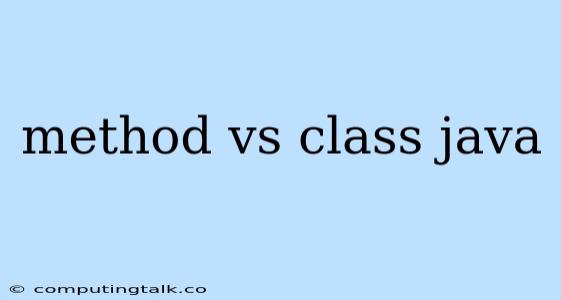In Java, the concepts of methods and classes are fundamental building blocks of object-oriented programming. Understanding their roles and relationships is crucial for writing efficient and maintainable Java code.
What is a Class?
A class in Java serves as a blueprint or template for creating objects. It encapsulates data (attributes) and behaviors (methods) that define the characteristics and actions of objects belonging to that class. Think of it like a cookie cutter: you can use the same cutter to create multiple cookies, each with the same shape but potentially different decorations.
Here's an example:
public class Dog {
private String name;
private int age;
public void bark() {
System.out.println("Woof!");
}
public void eat() {
System.out.println("Eating dog food.");
}
}
This code defines a class called Dog. It has two attributes: name and age, representing the dog's name and age. It also has two methods: bark() and eat(), representing the dog's actions.
What is a Method?
A method in Java is a block of code that performs a specific task. It's a function that belongs to a class. Methods are responsible for implementing the actions that objects can perform.
Here's an example:
public void bark() {
System.out.println("Woof!");
}
This code defines a method called bark(). It prints the string "Woof!" to the console, representing the dog's barking sound.
Relationship between Methods and Classes
A method is always associated with a class. It cannot exist independently. In other words, a method must be defined within a class.
Think of it like this:
- A class is like a blueprint for a house.
- A method is like a specific room in that house, with a defined purpose.
You can have multiple methods within a single class, each performing a different task.
How to Use Methods
To use a method in Java, you need to create an object of the class that contains that method. Once you have an object, you can call the method on that object using the dot operator.
Here's an example:
Dog myDog = new Dog();
myDog.bark(); // This will call the bark() method on the myDog object
In this example, we first create an object of the Dog class called myDog. We then call the bark() method on the myDog object, which causes the dog to "bark" (print "Woof!" to the console).
Key Differences between Methods and Classes
| Feature | Class | Method |
|---|---|---|
| Purpose | Blueprint for objects | Code block that performs a task |
| Structure | Contains attributes and methods | Contains code instructions |
| Independence | Cannot exist independently | Always associated with a class |
| Usage | Used to create objects | Used to perform actions on objects |
When to Use Methods and Classes
- Use classes to organize your code into reusable modules and represent real-world entities.
- Use methods to break down complex tasks into smaller, manageable pieces.
- Use methods to encapsulate common logic and improve code readability.
Conclusion
In Java, methods and classes are essential components for building object-oriented programs. Understanding their roles and relationships is crucial for writing clear, efficient, and maintainable code. By using classes to define blueprints and methods to encapsulate actions, you can create powerful and modular programs that effectively model real-world concepts.
